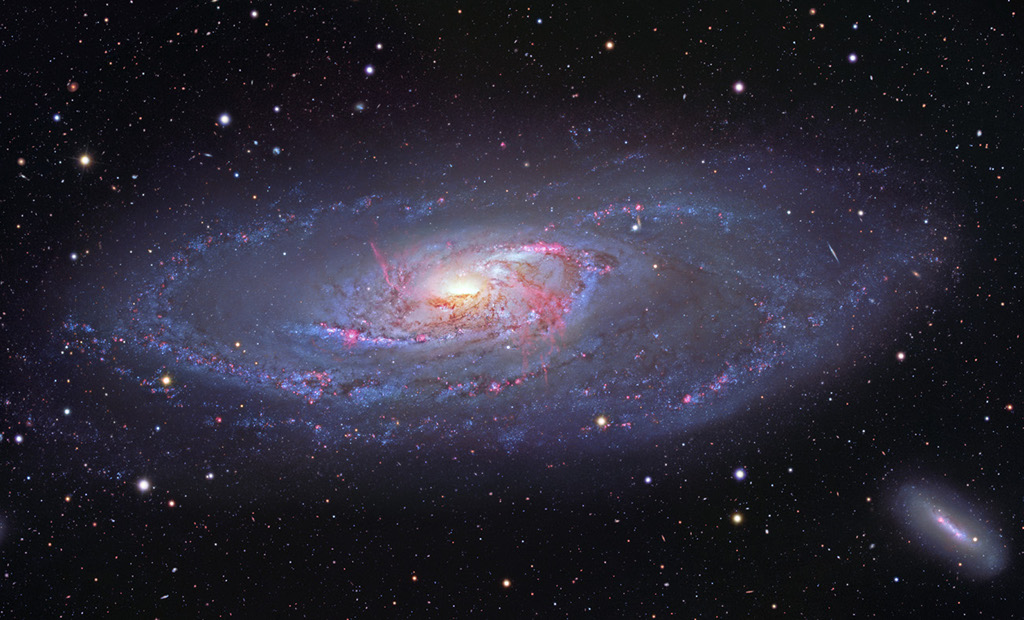09. April 2021
Messier 106

探索宇宙1!逐工會揀一幅無仝款 ê 影像抑是相片,𤆬你熟似咱這个迷人 ê 宇宙,閣有專業天文學者2為你3解說4。
- 原始文章:Messier 106
- 影像來源:NASA, Hubble Legacy Archive, Kitt Peak National Observatory;
- 業餘資料 kah 處理 ê 版權:Robert Gendler
- 台文翻譯:An-Li Tsai (NCU)
[漢羅] Messier 106
這个美妙 ê 天體 to̍h tī 大隻熊(大熊座)附近,去予 獵狗(獵犬座)ê 恆星箍 tī 內底。 伊是 1781 年去予 使用公制 ê 法國天文學家 Pierre Mechain 發現 ê。 了後,才予伊 ê 朋友兼同事 Charles Messier 收入去 Messier 星表內底,號做 M106。 近代 ê 深空望遠鏡影像顯示,伊是一粒 宇宙島,是一个差不多 3 萬光年闊 ê 捲螺仔星系,to̍h tī 離咱銀河內底 ê 恆星 2100 萬光年遠 ê 所在。 伊 ê 中心有一粒足光 ê 銀核。 這个予人讚嘆 ê 星系畫面,是 ùi 業餘 kah 專業 ê 天文望遠鏡影像 kā 敆做伙 ê。 影像內底明顯看會著 ê,是少年 ê 藍光星團 kah 紅色 ê 恆星托兒所。 In to̍h 綴著星系 ê 捲螺仔手骨 方向。 你嘛看會著足明顯 ê 紅色 噴流,伊是水素氣體發出 ê 光。 除了正爿下跤 ê 細粒星系伴 NGC 4248 以外,猶閣會當 tī 這幅圖內底揣著四散 ê 背景星系。 M106,嘛號做 NGC 4258,是一粒鄰近 ê Seyfert 型活潑星系。 In ê 光譜 ùi 電波到 X-光攏看會著。 活潑星系 ê 動力,是 ùi 落落去 星系中心大質量烏洞 ê 物質提供 ê。
[POJ] Messier it-khòng-lio̍k
Chit-ê bí-miāu ê thian-thé to̍h tī tōa-chiah-hîm (Tāi-hîm-chō) hū-kīn, khì hō͘ la̍h-kàu (La̍h-khián-chō) ê hêng-chhiⁿ kho͘ tī lāi-té. I sī it-chhit-pat-it nî khì hō͘ sú-iōng kong-chè ê Hoat-kok thian-bûn-ha̍k-ka Pierre Mechain hoat-hiān ê. Liáu-āu, chiah hō͘ i ê pêng-iú kiam tông-sū Charles Messier siu ji̍p-khì Messier seng-pió lāi-té, hō-chòe M-it-khòng-lio̍k. Kīn-tāi ê chhim-khong bōng-oán-kiàⁿ iáⁿ-siōng hián-sī, i sī chi̍t-lia̍p ú-tiū-tó, sī chi̍t-ê chha-put-to saⁿ bān kng-nî khoah ê kńg-lê-á seng-hē, to̍h tī lî lán Gîn-hô lāi-té ê hêng-chhiⁿ nn̄g-chheng-chi̍t-pah bān kng-nî hn̄g ê só͘-chāi. I ê tiong-sim ū chi̍t-lia̍p chiok-kng ê gîn-he̍k. Chit-ê hō͘ lâng chàn-thàn ê seng-hē ōe-bīn, sī ùi gia̍p-û kah choan-gia̍p ê thian-bûn bōng-oán-kiàⁿ iáⁿ-siōng kā kap-chòe-hóe--ê. Iáⁿ-siōng lāi-té bêng-hián khòaⁿ-ē-tio̍h ê, sī siàu-liân ê nâ-kng seng-thoân kah âng-sek ê hêng-chhiⁿ thok-jî-só͘. In to̍h tòe-tio̍h seng-hē ê kńg-lê-á chhiú-kut hong-hiòng. Lí mā khòaⁿ-ē-tio̍h chiok bêng-hián ê âng-sek phùn-liû, i sī chúi-sò͘ khì-thé hoat--chhut ê kng. Tû-liáu chiàⁿ-pêng-ē-kha ê sè-lia̍p seng-hē-pôaⁿ NGC sù-jī-sù-pat ì-gōa, iáu-koh ē-tàng tī chit-pak-tô͘ lāi-té chhōe-tio̍h sì-sòaⁿ--ê pōe-kéng seng-hē. M-it-khòng-lio̍k, mā hō-chòe NGC sù-jī-ngó͘-pat, sī chi̍t-lia̍p lîn-kīn ê Seyfert-hêng oa̍h-phoat seng-hē. In ê kng-phó͘ ùi tiān-pho kàu X-kng lóng khòaⁿ-ē-tio̍h. Oa̍h-phoat seng-hē ê tōng-le̍k, sī ùi lak-lo̍h-khì seng-hē tiong-sim tōa-chit-liōng o͘-tōng ê bu̍t-chit the̍h-kiong--ê.
[KIP] Messier it-khòng-lio̍k
Tsit-ê bí-miāu ê thian-thé to̍h tī tuā-tsiah-hîm (Tāi-hîm-tsō) hū-kīn, khì hōo la̍h-kàu (La̍h-khián-tsō) ê hîng-tshinn khoo tī lāi-té. I sī it-tshit-pat-it nî khì hōo sú-iōng kong-tsè ê Huat-kok thian-bûn-ha̍k-ka Pierre Metsain huat-hiān ê. Liáu-āu, tsiah hōo i ê pîng-iú kiam tông-sū Tsarles Messier siu ji̍p-khì Messier sing-pió lāi-té, hō-tsuè M-it-khòng-lio̍k. Kīn-tāi ê tshim-khong bōng-uán-kiànn iánn-siōng hián-sī, i sī tsi̍t-lia̍p ú-tiū-tó, sī tsi̍t-ê tsha-put-to sann bān kng-nî khuah ê kńg-lê-á sing-hē, to̍h tī lî lán Gîn-hô lāi-té ê hîng-tshinn nn̄g-tshing-tsi̍t-pah bān kng-nî hn̄g ê sóo-tsāi. I ê tiong-sim ū tsi̍t-lia̍p tsiok-kng ê gîn-hi̍k. Tsit-ê hōo lâng tsàn-thàn ê sing-hē uē-bīn, sī uì gia̍p-û kah tsuan-gia̍p ê thian-bûn bōng-uán-kiànn iánn-siōng kā kap-tsuè-hué--ê. Iánn-siōng lāi-té bîng-hián khuànn-ē-tio̍h ê, sī siàu-liân ê nâ-kng sing-thuân kah âng-sik ê hîng-tshinn thok-jî-sóo. In to̍h tuè-tio̍h sing-hē ê kńg-lê-á tshiú-kut hong-hiòng. Lí mā khuànn-ē-tio̍h tsiok bîng-hián ê âng-sik phùn-liû, i sī tsuí-sòo khì-thé huat--tshut ê kng. Tû-liáu tsiànn-pîng-ē-kha ê sè-lia̍p puânn NGC sù-jī-sù-pat ì-guā, iáu-koh ē-tàng tī tsit-pak-tôo lāi-té tshuē-tio̍h sì-suànn--ê puē-kíng sing-hē. M-it-khòng-lio̍k, mā hō-tsuè NGC sù-jī-ngóo-pat, sī tsi̍t-lia̍p lîn-kīn ê Seyfert-hîng ua̍h-phuat sing-hē. In ê kng-phóo uì tiān-pho kàu X-kng lóng khuànn-ē-tio̍h. Ua̍h-phuat sing-hē ê tōng-li̍k, sī uì lak-lo̍h-khì sing-hē tiong-sim tuā-tsit-liōng oo-tōng ê bu̍t-tsit the̍h-kiong--ê.
[English] Messier 106
Close to the Great Bear (Ursa Major) and surrounded by the stars of the Hunting Dogs (Canes Venatici), this celestial wonder was discovered in 1781 by the metric French astronomer Pierre Mechain. Later, it was added to the catalog of his friend and colleague Charles Messier as M106. Modern deep telescopic views reveal it to be an island universe - a spiral galaxy around 30 thousand light-years across located only about 21 million light-years beyond the stars of the Milky Way. Along with a bright central core, this stunning galaxy portrait, a composite of image data from amateur and professional telescopes, highlights youthful blue star clusters and reddish stellar nurseries tracing the galaxy's spiral arms. It also shows off remarkable reddish jets of glowing hydrogen gas. In addition to small companion galaxy NGC 4248 at bottom right, background galaxies can be found scattered throughout the frame. M106, also known as NGC 4258, is a nearby example of the Seyfert class of active galaxies, seen across the spectrum from radio to X-rays. Active galaxies are powered by matter falling into a massive central black hole.
詞彙學習
| 漢羅 | POJ | KIP | 華語 | English |
|---|---|---|---|---|
| 大熊座 | Tāi-hîm-chō | Tāi-hîm-tsō | 大熊座 | Ursa Major |
| 獵犬座 | La̍h-khián-chō | La̍h-khián-tsō | 獵犬座 | Canes Venatici |
| 捲螺仔星系 | kńg-lê-á seng-hē | kńg-lê-á sing-hē | 螺旋星系 | spiral galaxy |
| 銀核 | gîn-he̍k | gîn-hi̍k | 銀核 | galactic core |
| 捲螺仔手骨 | kńg-lê-á chhiú-kut | kńg-lê-á tshiú-kut | 螺旋手臂 | spiral arm |
| 業餘 | gia̍p-û | gia̍p-û | 業餘 | amateur |
| 噴流 | phùn-liû | phùn-liû | 噴流 | jet |
| 水素 | chúi-sò͘ | tsuí-sòo | 氫 | hydrogen |
| 星系伴 | seng-hē-pôaⁿ | puânn | 伴星系 | companion galaxy |
| 活潑星系 | oa̍h-phoat-seng-hē | ua̍h-phuat-sing-hē | 活躍星系 | active galaxy |